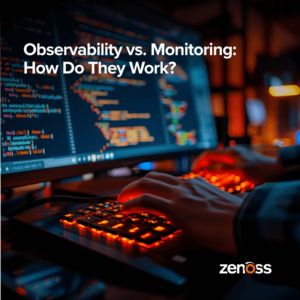
Together, Zenoss marketing strategist Deepak Kanwar and deployment architect Michael Shannon showed how using a unified monitoring solution (specifically ZSD, which Mike gives a clear-eyed demo of) minimizes, even eliminates the dreaded “I don’t know” response whenever your IT environment suffers disruptions or degradations without having to drag multiple SMEs away from their real responsibilities to troubleshoot these problems.
As Deepak said at the start of the webcast:
- When a CIO asks you why there is a disruption, it’s because he or she received a phone call from a major customer, the CFO, or even the CEO wanting to know why that service no longer available. Downtime is extremely expensive and knowledge of it percolates quickly up the ranks. You don’t want to say “I don’t know,” but too often it’s the only answer you can give if you don’t have the right tools in place.
Once More With Feeling: The Problem With Point Tools
The Zenoss blog has spent the last year or so discussing the pitfalls of relying on point tools for IT monitoring. My first recap back in February was for the webinar Using Too Many Tools Hinders IT Operations, which was based on a January 2013 Zenoss-commissioned Forrester Consulting white paper surveying 161 North American IT decision-makers about their IT monitoring.
There, I wrote:
- Almost 70% of the decision-makers Forrester surveyed used a minimum of 10 different monitoring tools to keep tabs on their IT infrastructure. Garbani, Vice President and Research Analyst at Forrester, said that this stockpiling of tools usually happens because each silo within an IT organization buys what they think will do the best job possible. Almost 60% of the respondents agreed that the accumulation of application and IT management software creates more challenges than it solves. And this problem continues to escalate as more and more IT infrastructures build out.
In this latest webinar, Mike, who has spent years deploying IT monitoring solutions, said that at the higher levels, companies don’t even know how many tools they have!
Said Mike:
- Having 50+ tools in a large company, you could easily hit that. A lot of [these tools] have been written in-house for particular departments or for specialized applications. These tools might be scripts that test out websites [or] vendor-provided tools for particular applications or particular pieces of hardware. Until somebody starts really digging into what monitoring tools they have, nobody in the organization really knows.
As Deepak said, this outdated strategy of using point tools to monitor infrastructure just doesn’t work in a cloud-era data center:
- Relationships are dynamic. Infrastructure components are supporting one service today but maybe not tomorrow because things have changed and load balancers have moved the workloads to a different machine. So how do you keep track of that? You absolutely need unified monitoring to get an idea of what's going on in your environment and to understand what needs to get done to restore your services quickly.
Given the rapid changes in technology, your unified monitoring solution not only needs to be flexible enough to handle your hybrid IT environment in a holistic fashion but should also be extensible enough to accommodate new platforms as they emerge.
What We Mean When We Say ‘Unified Monitoring’
Deepak reviewed the reasons why hybrid IT infrastructures need unified monitoring:
- In the last few years a lot of things have happened that have completely changed the face of IT. It's not the good old IT of yesterday, where we had a few dedicated servers, a few storage arrays, and off we went. Now we have a portfolio of products, virtualized, dedicated, clouds etc., managing them right and making sure things are working together can create sustainable competitive advantage for us, something IT did not have to do before.
As Deepak said, the mounting complexity within everything but the simplest data centers is starting to create more disruptions:
- We find ourselves experiencing more frequent outages with longer periods of downtime. Resolution takes time and gets more expensive because we need to bring in SMEs (Subject Matter Experts) to solve these problems. It’s just not a scalable process.
Deepak’s thoughts made me think about another recent webinar What’s Not So Cool About Netcool. In that webcast Zenoss director of product marketing Scott Hollis clarified that a unified monitoring solution is more than a unified invoice. For example, the IBM/Tivoli unified monitoring “solution” is really made up of 10 separate tools that don’t originate from a common code base and use separate databases and even separate UIs.
Unlike a unified monitoring solution such as ZSD, the Tivoli option is a nightmare to manage because you need to custom-build connectors between the different products so they can communicate, and then continually update them so they stay in sync. You can’t expect a solution based on a 90s-era framework to handle the dynamism of today’s hybrid IT environments.
In contrast, a solution like ZSD has been built “from the ground up” specifically to handle cloud-era IT environments. Mike’s demo shows in detail about how its three primary components work together to give you full visibility over your infrastructure and how Zenoss ZenPacks make the overall ZSD solution extensible to handle myriad data center architectures.
What ‘I Don't Know’ Really Means
Why is a unified monitoring solution like ZSD the only viable approach for modern data centers? It all goes back to Deepak’s concept of “I don't know.” Personally, I think the concept is brilliant. “I don’t know” is just plain English for “Mean Time To Know” or “MTTK.” The recent post, Who’s Afraid of IT Monitoring Solutions? (Webinar Recap), offers a nice introduction on how reducing MTTK will reduce your “Mean Time To Repair/Resolution” or “MTTR.”
In this latest webinar, Deepak explained:
- MTTK is time required to determine root cause of an issue, and MTTR is heavily dependent on MTTK. During this time, you cannot answer your CIO with any certainty on what's wrong. "We're working on it, but I don't know what's wrong or when it will be fixed."
Because so many data centers still rely on point tools, MTTR can turn into an all-day or even multi-day process.
Said Deepak:
- According to [the August 2013 Forrester report], 34% of those surveyed said it takes from a half day to more than a day to resolve problems with mission-critical applications. A lot of this is happening because of the reliance on point tools. These tools don't talk to one another, because they’re designed for a specific component or technology rather than an application or service. So you can’t figure out what an alert really means because your tools are not providing you any context around what’s going wrong. So you need a lot of intervention from SMEs pulled from different domains within your organization—and most of them already have a day job!
Of those surveyed in the Forrester report, 72% say determining the root cause of a problem requires human intervention, and 63% need the help of between four and ten or more full-time employees to address a major disruption.
That’s insane! If you have the choice of either devoting so many IT resources to identify and solve a problem or implementing a true cloud-era unified monitoring solution that automates the root cause analysis process, what would you choose? I know my answer.







